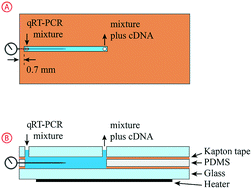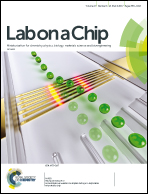Lab-on-a-chip mRNA purification and reverse transcription via a solid-phase gene extraction technique
Abstract
Extraction and purification of high quality RNA is a crucial initial step required for a variety of genomic assays. We report a solid phase gene extraction (SPGE) method for automated extraction, purification and reverse transcription of mRNA in a microfluidic device. This is performed using a 130 μm diameter stainless steel needle that is amino-linked to dT(15) oligonucleotides for selective hybridization of mRNA. By inserting this probe into the biological sample for only 30 seconds, mRNA is captured with high selectivity and a yield greater than 10 pg per mm of probe length. The probe is then inserted into a lab-on-a-chip device, where the bound poly-adenylated RNA is thermally released and immediately reverse transcribed for subsequent PCR amplification. The insertion of the probe into the microfluidic device is straightforward: the microchannel is formed with an elastomer (PDMS) that, when punctured, will seal around the probe. The specificity and RNA loading capacity of the probes were evaluated using conventional qPCR. This procedure was successfully used to extract, purify, and transcribe mRNA from rat glioblastoma cell spheroids in less than seven minutes. Analysis of the product confirmed that the SPGE technique selectively captures and inherently purifies high-quality mRNA directly from biological material with no need for additional pre-processing steps. Integrating this elegant sample preparation method into a complete lab-on-a-chip system will substantially enhance the speed and automation of mRNA assays for research and clinical diagnostics.



 Please wait while we load your content...
Please wait while we load your content...